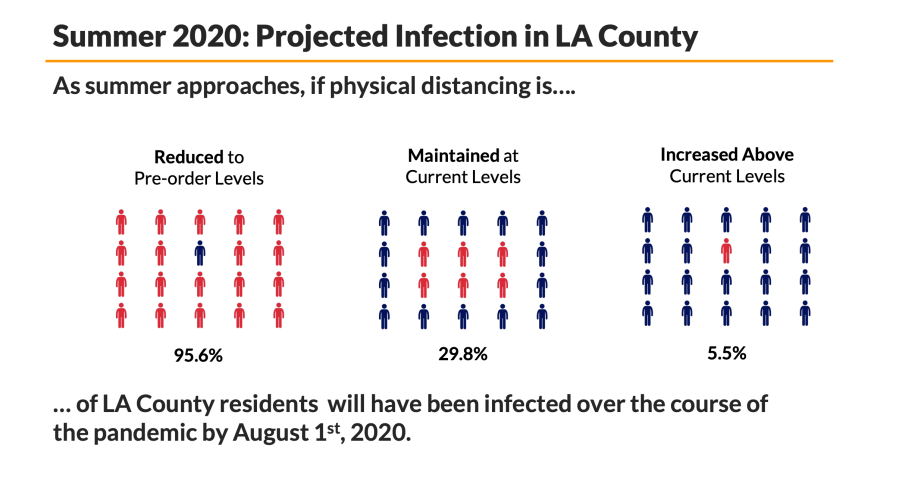Los Angeles County on Friday extended its stay-at-home order an additional month through at least May 15 in a continuing effort to curb the spread of COVID-19.
Dr. Barbara Ferrer, the county’s public health director, said that officials are extending the order because it is helping in the fight against COVID-19, but “we still have a ways to go.”
According to projections by the county, if the stay-at-home order was lifted too quickly and people resumed daily life, 95.6% of residents in the county would be infected with coronavirus, said Christina Ghaly, the county’s health services director.
If physical distancing measures continue, the overall infection rate of the community could go down to 30% by August, the projections show.
“That’s a huge decline,” Ghaly said.

The “Safer at Home” order was first issued by the county on March 19 and was originally effective through April 19.
“Because everyone here is doing their part, because people are heeding the directives … what we can confirm is in fact the flattening of the curve in a way that’s actually saving lives and allowing us to have a chance at making sure that our healthcare system remains able to serve all who need care,” Ferrer said.
She said residents should continue social distancing measures because the virus is still spreading in L.A. County. The number of coronavirus cases in the county increased Friday to 8,430 and the death toll reached 241. The mortality rate also increased again to 2.9% countywide.
“I know that many of you were hoping we would get to the end of April and we’d be able to lift many of these restrictions,” Ferrer said. “I am as sad as you are to note that this is not the time to lift.”
As part of the extended order, all indoor and outdoor private gatherings and events should not occur, beaches and trailheads, as well as all nonessential businesses, remain closed.
New measures taking effect at midnight April 15 to make sure people working essential services are safer include:
- All essential businesses must provide all employees who are required to be around others a cloth face covering to wear while performing duties.
- Employers should provide a plan, share it with employees and post it somewhere visible at the business that explains how they’re implementing physical distancing and cleaning requirements in the workplace.
In addition, those going into a business or site that provides essential services need to put on a face covering, Ferrer said.
She noted that it is still OK to engage in outdoor activities alone or with members of your household, and residents can still leave their homes to access or provide essential services, as long as they are practicing physical distancing and wearing a cloth face covering while out with others.
“Extending ‘safer at home’ really means that we are able to keep in place the measures that we know are working and preventing a huge acceleration of COVID-19 cases,” Ferrer said.
The county continues to expand testing and more mobile testing sites are opening up, particularly in underserved communities.
And starting Friday, six sites across the county will be used to test for coronavirus antibodies to find out how many people have already fought off the virus.
Officials will be testing 1,000 randomly selected people and testing will continue in the next few months.
Ferrer said the study won’t reveal if people who were infected are now immune, but officials assume that they are based on studies of other viruses.
“Everyday we do get closer to being on the other side of this,” Ferrer said.
Also on Friday, Ferrer provided her daily breakdown of coronavirus figures:
- 2,043 people have been hospitalized while positive for COVID-19 — that’s 24% of all positive cases.
- About 20% of people who required hospitalization also needed a ventilator at some point.
- County officials are investigating 159 institutional settings with at least one confirmed case.
- Total confirmed cases in those kinds of facilities jumped to 1,062: 506 are residents and 556 are staff.
- 67 people who have died of COVID-19 in the county were residents in institutional settings, including nursing facilities and assisted living facilities. This now represents 28% of all deaths, meaning more than 1 of 4 people who have died were people residing in institutional settings.
- The cases in institutional settings also include 53 cases across county jails, 23 cases in state prisons, and two staff members at juvenile facilities.
- There are now 18 cases among people experiencing homelessness, that’s down two cases that were found to not be positive after further investigation.





















